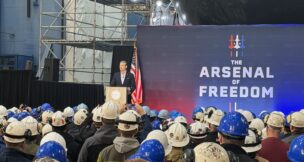Tech students dig into high-tech mock mine
Paul Bibeau //March 30, 2023//
Robots don’t belong on volleyball courts, but for more than a decade Virginia Tech students had no other large, sandy place to test out mining robots.
It was “a real lost opportunity” that students didn’t have a dedicated space to work with mining machines, says Erik Westman, a professor and interim department head at Tech’s Department of Mining and Minerals Engineering.
Now students have a mock mining lab to study challenges facing the increasingly automated mining industry.
Built as part of a $73.5 million renovation of Holden Hall completed last year, the Center for Autonomous Mining Systems is a 1,200-square-foot mock mine with three large rectangular pits that can be filled with mined material like crushed limestone.
Before building the lab, school officials consulted mining companies about skills they’re seeking from today’s workers, Westman says.
“One of the biggest issues they’re dealing with is all of the data coming from the equipment,” he says. At the new center, students learn to analyze data from robotic equipment to make mining safer and more efficient.
Tech senior Christopher Keesee wants to find a job in data analytics, “where we’re looking at cycle times … [and] looking at drilling data and things like that to optimize their operation.”
Within the next five years, students might be able to model entire mining systems in the mock mine, with researchers making robotics efficiency improvements to aid the industry, Westman says.
Hard-rock mining companies are already taking steps to automate, moving faster than other kinds of mining operations such as coal mining, according to Ken Matney, senior electrical engineer with Simmons Equipment Co., a Tazewell County-based mining equipment manufacturer.
Market research firm Technavio says mining industry investment in robotics is expected to increase by more than $2 billion from 2021 to 2026.
Tech students are also using the mining lab to test mining robots they are designing and building for a NASA-sponsored simulated lunar robotic mining competition.
NASA Lunabotics Project Manager Richard Johanboeke says the competition preps students for earthbound high-tech jobs as well as work that could further space exploration: “These industries will create a workforce poised to lead a new space-based economy and add to the economic strength of our country.” NASA expects to launch the Polar Resources Ice Mining Experiment-1 (PRIME-1) later this year to search for water at the moon’s lunar South Pole.
i













